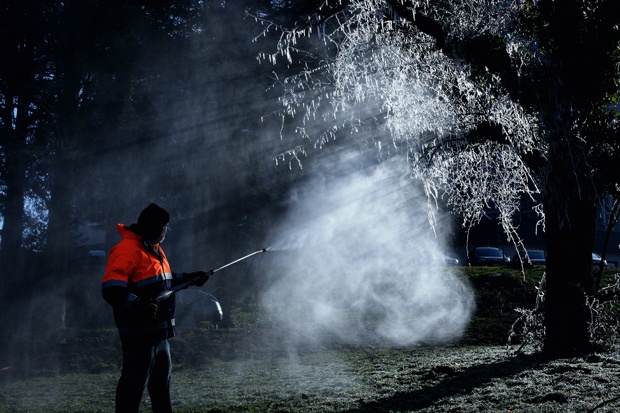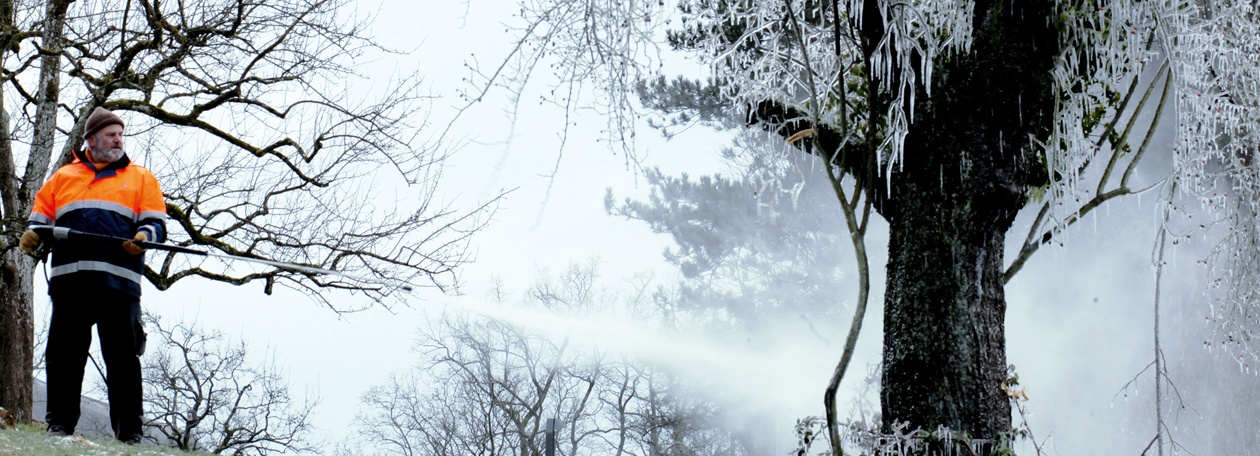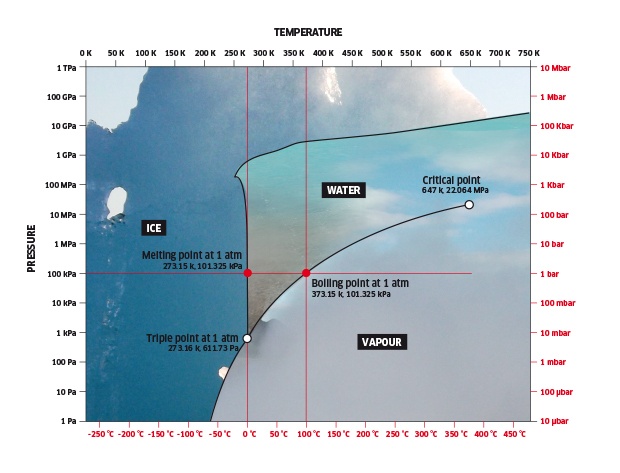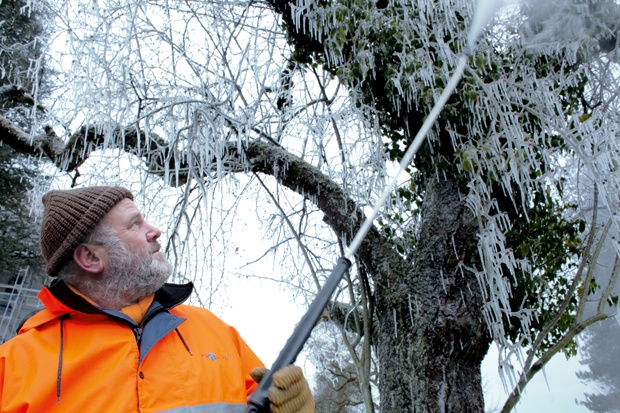Nature as the Artist
Sparkling ice needles, glinting wafts of mist, white frost – nature is full of fascinating phenomena. Thomas Rappaport is an artist with an eye for them. The focus of his project "spray - melting sculptures" is the end of the life of a cherry tree. After 80 years of blossoming, coming to red rich fruition, giving shade and being part of the all-terrain microclimate, the artist creates a unique portrait of the tree.

Thomas Rappaport about his art project
The concept of "spray", explains a natural phenomenon where the wind brushes over the sea, absorbing water droplets, and then leaves them on anything it brushes past which waits at the shore, such as trees. If the temperature is below zero, this then creates bizarrely beautiful sculptures in ice, on the trees.
Water as "art stuff"
I started out as a wood-carver, creating traditional classic wooden sculptures, the ones which are generally put on a pedestal. Over the years, I have discovered the tree as a whole, as a material in itself – for a time I would only see the dead trunks standing there, but now I have finally come to recognize the tree whilst it’s still alive. Some years ago I discovered by chance that my wooden sculptures appear totally different when put into water. Through buoyancy one part of it stays under water, however, it is still visible. Light is refracted at water level and so is the form of the sculpture.
Additionally I re-discovered something: There is the tradition of rafting in order to transport tree trunks through creeks and rivers, even over long distances. In English you call this „water-borne timber“. And if I interpret this expression freely it means „wood which was born from water“. By taking photographs of my floating wooden sculptures („rafts“) underneath the water level these optical refractions and reflections became visible. Thus I started to perceive and appreciate water itself as „art stuff“ to create with.
It inspired me to „look over nature’s shoulder“. It uses heat and cold like a sculptor his chisel. There is even a triple point, where pressure ratio and temperature come together in such a way, that water is a liquid, solid (ice) and gas (vapour/fog) at the same time - well nearly!
All these experiences influenced my giSCHt-project: I sprayed the dead cherry tree with a hot water high-pressure cleaner several times at temperatures below zero, i.e. permanent frost. The entire structure of the tree was to be completely enveloped in solid layers of ice.

In harmony with nature
I got to know the tree at different times of the year very well while I prepared myself for „giSCHt“. The intensive work during the day and night, with daylight and artificial light turned my experiences into a dialogue.
How does a tree accept water? How does it cope with the cold? Parts of the ice melted away again, smaller twigs broke under the weight. The challenge was to vary the water jet, to rhythmize it, to get it moving, in free fluid forms, to enter the flow – if only for a moment. One part of this art concept is based on scientific facts. This led to inspiring conversations with participants of an international agricultural congress which took place in the neighbourhood. There used to be – and obviously still are – fruit farmers who enwrapped their blossoms with a spray when night frosts threatened to destroy them, in other words the crops of summer were at stake. The spray formed an ice shield which protected the plants from frost.
A paradox: By doing so, a kind of „heat pad“ is formed at about one degree below zero. This in turn shields the blossoms from radiation frost, which may hit at around ten degrees minus.

Water's states of aggregation
The pressure-temperature-diagram
The pressure-temperature-diagram presents the transformations into the different states of matter. It shows something fascinating: there is a stage where water can take up all three states at the same time – dependent on ambient pressure and temperature. This is called the triple point.
For his giSCHt-project Thomas Rappaport sprays hot vapour on a dead cherry tree. It disseminates through the air and gently covering the trunk and branches. Hoarfrost evolves. By spraying more and more atomized water onto the tree an ice shield is formed – artistic and impressive. This shield protects the buds of a tree from night frosts which can reach temperatures far below ten degrees Celsius, because under the ice shield the temperature doesn’t go below minus one degree Celcius. In this biological processes are certainly not impaired.
When liquid water boils – this happens at sea level at 100 degrees Celsius – it becomes steam. Cooling down to zero degrees it solidifies to ice. In reverse, ice melts at zero degrees to water. Steam on the other hand condenses at 100 degrees Celsius to water. Finally, there is the phenomenon when ice transforms directly into a gaseous state, i.e. without going through the liquid aggregate phase. This is technically called sublimation. In this case the ice dries out, so to speak. To the contrary, steam can resublime to ice – visible as frost flowers or hoarfrost.
Fog emerges if tiny droplets of water are distributed in the air. When the air cools down its capacity to take up water decreases, which causes water to condensate. Hoarfrost builds up when hypothermic steam transforms directly from its gaseous phase into the solid one, which happens at temperatures below zero degrees Celsius.


Water is life – without water there remains no life
Water exists on Earth in different states and forms. Sun vaporizes liquid water to steam, it can reform as clouds or fog – and recurs to Earth as rain. At temperatures under zero degrees Celsius water starts to freeze and form the solid ice. Glaciers remind us of the last ice age which ended at around 10.000 years ago. On the other hand there is the phenomenon of geothermics: Terrestrial heat warms up the water underground, thus creating hot springs. They leak out of the Earth as gas, in cooler air it condenses quickly to vapour – a state of equilibrium between liquid and gaseous state.
From everyday life we know water’s three states, also called aggregate phases:
- solid
- liquid
- gaseous
In its solid phase water keeps its shape, liquidly it adapts itself to the form of its surroundings, and finally as a gas it fills up completely the space available.
Thomas Hoffmann, Mathematician, Water Economist, Sculptor and Educator
About Thomas Rappaport
- 1957 born in Zürich
- "Abitur" at a secondary school of fine arts
- Apprenticeship as a wood sculptor
- Work as a remedial teacher
- Studies at the Freie Hochschule Stuttgart
- Teacher for arts and crafts
- Lecturer in adult education
- Since 1998 own studio in Wildpark Stuttgart
- Since 1999 free art projects in the forest
- Since 2008 freelance artist.
"In his oeuvre, human creativity merges with natural conception, artistic work with god’s creation. He entrusts himself and his art completely to nature, takes on its materials and forces, always led by his long experience and deepest respect. He develops performances with an enormous technical effort and nature in powerful rituals. It is most impressive how then the beauty and powers of nature come into fruition."
Dr. Tobias Wall, Art Historian

